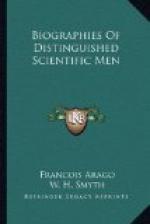Very small stars seemed to grow much paler when they were seen through the coma or through the tail of the comet.
This faintness may have only been apparent, and might arise from the circumstance of the stars being then projected on a luminous background. Such is, indeed, the explanation adopted by Herschel. A gaseous medium, capable of reflecting sufficient solar light to efface that of some stars, would appear to him to possess in each stratum a sensible quantity of matter, and to be, for that reason, a cause of real diminution of the light transmitted, though nothing reveals the existence of such a cause.
This argument, offered by Herschel in favour of the system which transforms comets into self-luminous bodies, has not, as we may perceive, much force. I might venture to say as much of many other remarks by this great observer. He tells us that the comet was very visible in the telescope on the 21st of February, 1808; now, on that day, its distance from the sun amounted to 2.7 times the mean radius of the terrestrial orbit; its distance from the observer was 2.9: “What probability would there be that rays going to such distances, from the sun to the comet, could, after their reflection, be seen by an eye nearly three times more distant from the comet than from the sun?”
It is only numerical determinations that could give value to such an argument. By satisfying himself with vague reasoning, Herschel did not even perceive that he was committing a great mistake by making the comet’s distance from the observer appear to be an element of visibility. If the comet be self-luminous, its intrinsic splendour (its brightness for unity of surface) will remain constant at any distance, as long as the subtended angle remains sensible. If the body shines by borrowed light, its brightness will vary only according to its change of distance from the sun; nor will the distance of the observer occasion any change in the visibility; always, let it be understood, with the restriction that the apparent diameter shall not be diminished below certain limits.
Herschel finished his observations of a comet that was visible in January, 1807, with the following remark:—
“Of the sixteen telescopic comets that I have examined, fourteen had no solid body visible at their centre; the other two exhibited a central light, very ill defined, that might be termed a nucleus, but a light that certainly could not deserve the name of a disk.”
The beautiful comet of 1811 became the object of that celebrated astronomer’s conscientious labour. Large telescopes showed him, in the midst of the gazeous head, a rather reddish body of planetary appearance, which bore strong magnifying powers, and showed no sign of phase. Hence Herschel concluded that it was self-luminous. Yet if we reflect that the planetary body under consideration was not a second in diameter, the absence of a phase does not appear a demonstrative argument.




